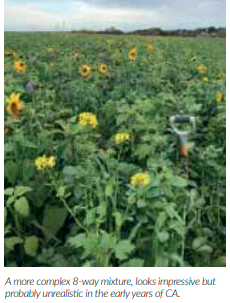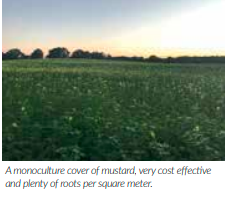Written by James Warne of Soil First Farming
A cover crop can be anything that is not intended to be harvested. It is simply there to provide soil cover, light
interception, push roots in the soil and carbon sequestration.
If you are following a true Conservation Agriculture (CA) system, cover cropping is an essential part of the system. The three principles of Conservation Agriculture are;
1, Minimum soil disturbance
2, Soil Cover
3, Diversity
The clue to cover crops is in the name, for them to work for you they need to firstly cover the soil, 100% of the soil, simple. While cover is the simplest measurement, they also intercept light and use photosynthesis to capture carbon and store it in the soil. Cover crops help us fulfil all three of the CA principles. Roots help to stabilise soil, and create structure by feeding biology, reducing the need for cultivation; providing soil cover when no cash crop is growing which protects the soil from the damaging compacting effects of rainfall and warming by the sun; and providing diversity in species and rotation.

Roots can help stabilise structureless soil and provide the ultimate cultivation.
A lot of CA promotion in the UK and abroad focuses on growing large biomass cover crops with multiple species, sometimes up to 15 different species in the cover crop. While this looks amazing and certainly does bring benefits, and is the eventual goal with cover crops there are downsides to this strategy particularly in the early years of CA adoption particularly with relation to cost.

It is easy to forget many of these amazing cover crops are being grown on soils that have been in CA system for many years and therefore have greater tilth and structure which provide better seed:soil contact to drill into and reliable establishment. There will certainly be better nutrient cycling, nutrient availability and greater water holding capacity and this is all due to the soil having more carbon stored within it. The Carbon to nitrogen ratio of the soil is also more likely to be in balance meaning the cover crop can access the nitrogen it requires. At Soil First Farming we believe in the early years it’s much better to stick to a simpler strategy and to build on this success year on year with increasing complexity of cover crop mix as you gain confidence in the system.
In the initial years stick to monocultures or mixtures with a maximum of three species. The soil is in ‘cultivation cold turkey’ at this point and it’s very easy for the soil to become compacted by trafficking at harvest, excessive precipitation and gravity. Therefore to stabilise the soil as quickly as possible you need roots, lots of roots. Focus on growing something cheap at a high seed rate to ensure not only soil cover but lots of roots per square metre. Preferably something with a reasonable taproot and some finer fibrous roots. Mustard is perfect for this. Crops in store can also provide a good starting point, such as OSR, Linseed, and be very cost effective.

It is very easy to lose confidence in the system in the early years especially when experience is low, the risk of cash or cover crop failure is high and there is little self-belief. To ward against this is it easy to think that if you spend a lot of money on a cover crop mix that you must be doing the right thing. Confidence then takes a crash as only two or three species of the expensive mix actually establish and the cover crop looks very thin and you realise it was an expensive mistake. In our experience it is much better to sow a simple crop and get it established in good time.
Many people get hung up on cover crop species and not wanting to grow brassicas or legumes because they have them as cash crops in the rotation already. We have been told not to grow these too close in rotation due to the potential build-up of soil borne pathogens such as club-root (a nutrition issue in reality) and rhizoctonia. But generally we don’t seem so concerned about growing cereals close in rotation. All of the in-field evidence suggests that using legumes and brassicas in cover crops does not increase the incidence of these pathogens providing they are not grown as a cover crop immediately prior to planting the same species as a cash crop. The only detrimental incidence I have seen is where BYDV incidence was high in crop of winter barley grown after spring barley volunteers were used as a cover and destroyed on the day of drilling the winter barley.
For over-wintered cover crops legumes are essential to balance out the large carbon input from straw and lignified cover crop residues. Too often we see situation where the following cash crop is struggling due to imbalanced soil carbon to nitrogen ratios, a big part of the feared yield dip. There is a desire to spend the budget on the seed and then forget nutrition. In order for cover crops to fulfil they part in the system we need them work hard, but to work hard they need nutrition. Chopped straw and other crop residues can quickly push the C:N too far in excess of carbon which then reduces the nitrogen available for the growing cover crop.
Most cover crops are destroyed before the crop has completed its full life cycle, we believe this is also detrimental for some pathogens which reduces the likelihood of pathogen build-up. As the soil biology begins to build we also see trash degrade quicker, large earthworm populations in particular can cover and digest chopped straw residues within a few months with ease. This reduces the chances of a green bridge effect of pathogen transfer. Some growers are also reporting that fusarium levels are much lower than the fusarium risk assessment would suggest. Again we believe this is attributable to increased straw digestion by greater soil biological activity. In our brave new world of Boris’s bold optimism it is important not to let the failures outweigh the successes. We must have a mindset of positive thinking and believe in the system for success.